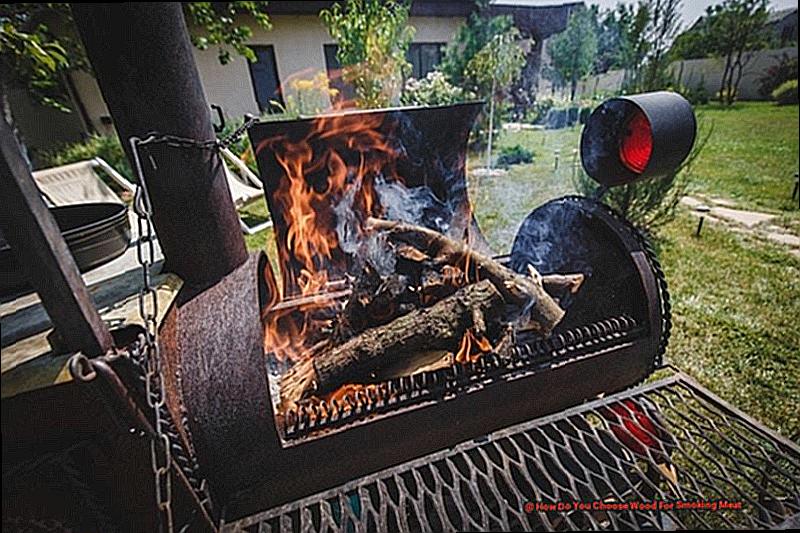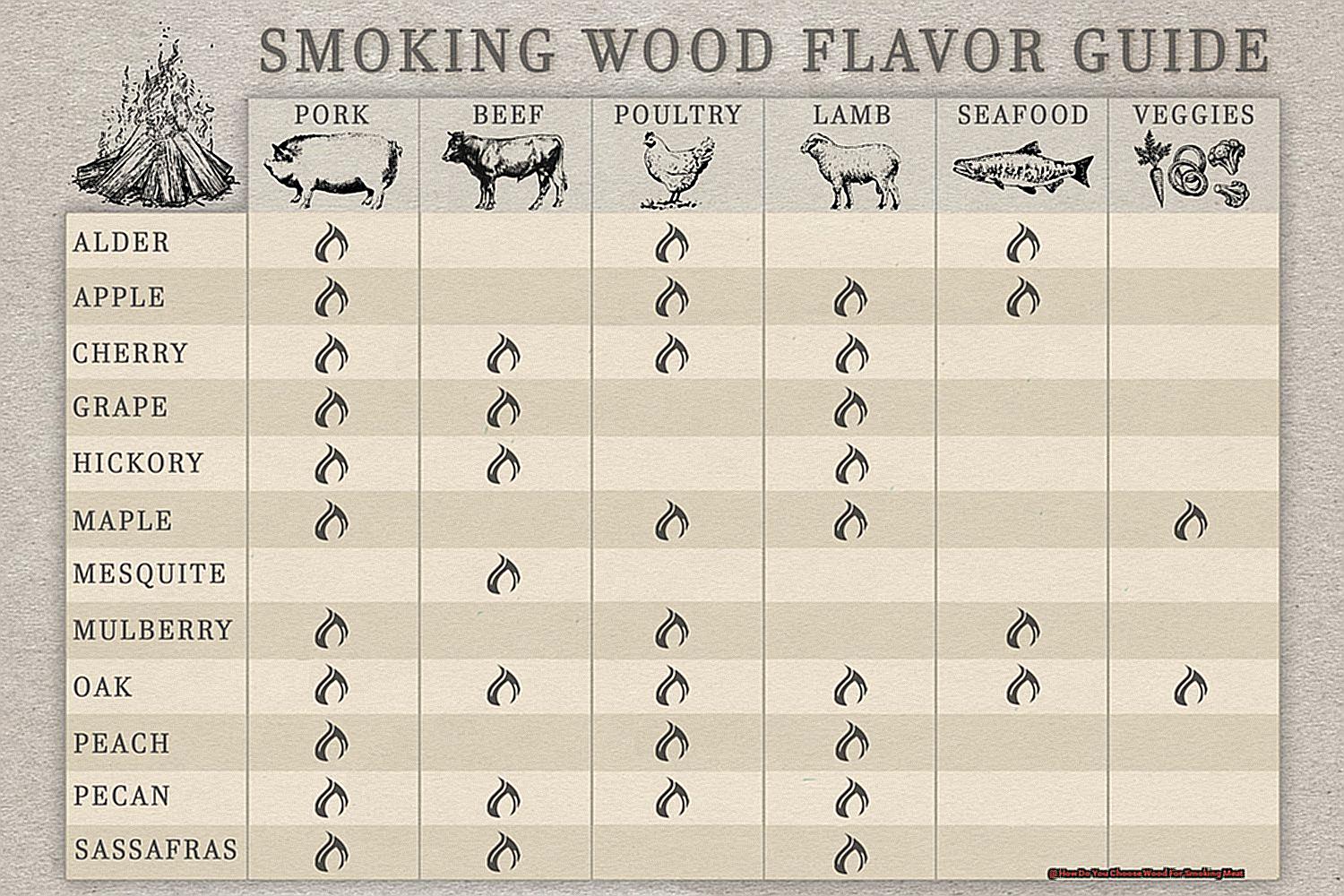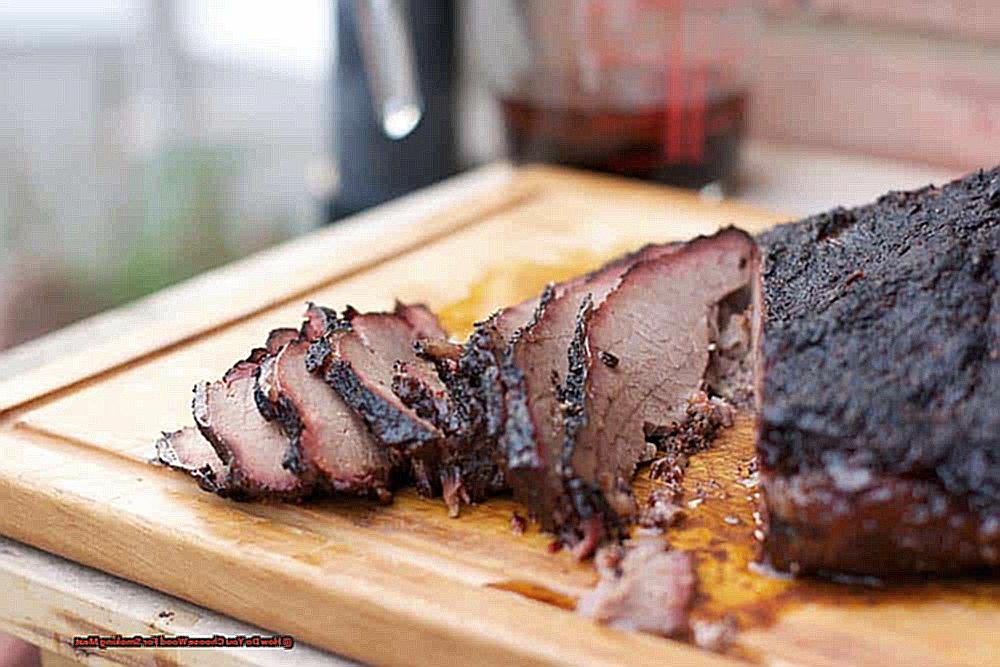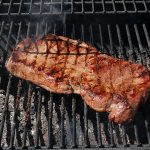Smoking meat is like taking a wild adventure through flavor town. It’s a journey that can transform the ordinary into the extraordinary, where every bite is a tantalizing explosion of taste. But here’s the secret sauce: the wood you choose is the compass that guides your culinary expedition.
It’s the key to unlocking those mouthwatering flavors, controlling the burn, and infusing your meat with that irresistible smoky essence.
So, get ready to embark on this flavorful escapade as we explore the captivating world of wood selection for smoking meat. Grab your apron and let’s dive right in.
Contents
Factors to Consider When Choosing Wood for Smoking Meat

Grilling is an art, and choosing the right wood for smoking meat is like selecting the perfect paintbrush for a masterpiece. The type of wood you use can make a world of difference in the flavor, aroma, and overall experience of your grilled dishes. In this article, we will explore the factors you should consider when selecting wood for smoking meat to help you elevate your grilling game.
Flavor Profile:
Different woods impart distinct flavors on meat, so it’s crucial to choose one that complements the type of meat and aligns with your taste preferences. Hickory offers a robust and smoky flavor, perfect for pork and beef. Fruitwoods like apple and cherry provide a milder, sweeter taste that pairs well with poultry and seafood. Experimenting with different wood flavors can unlock a world of delicious possibilities.
Intensity of Smoke:
Consider how intense you want the smoky flavor to be. Some woods produce heavy smoke, while others offer a more delicate touch. Pecan or alder woods are excellent choices if you prefer a subtle smoky taste, while mesquite or oak can provide a bolder flavor. Finding the right balance of smoke intensity can take your grilled dishes to new heights.
Availability:
Ensure the wood you choose is readily available in your region. Local woods are often fresher and higher in quality compared to imported varieties. Additionally, easily accessible wood ensures a consistent supply for your smoking needs.
Density and Heat Output:
The density of wood affects its burn time and heat production during smoking. Dense woods like oak and hickory burn slower and offer a steady heat source, making them ideal for longer smoking sessions. Lighter woods, such as fruitwoods, burn faster and produce less heat. Understanding density and heat output helps plan your smoking process efficiently.
Clean Burning:
Choose untreated hardwoods that have been properly seasoned to avoid releasing harmful toxins when burned. Using wood chunks or chips specifically designed for smoking ensures a cleaner and safer grilling experience.
Compatibility with Cooking Equipment:
Consider the type of smoker or grill you will be using. Different equipment may require specific sizes or shapes of wood chunks or chips. Ensure the wood you choose is compatible with your cooking equipment to achieve optimal results.
Hickory Wood
When it comes to adding that irresistible smoky flavor to your meats, hickory wood is the secret ingredient you need. In this blog post, we’ll delve into why hickory wood is a popular choice for smoking meat and how you can elevate your grilling game with this versatile wood.
Distinct Flavor Profile:
Hickory wood, with its strong and distinct flavor, adds a hint of sweetness and robust smokiness to your meats. This unique taste enhances the overall flavor profile of your dishes, making them irresistible to anyone’s taste buds. Whether you’re smoking pork, beef, or poultry, hickory wood will take your grilling experience to new heights.
Moisture Content Matters:
Selecting seasoned hickory wood with low moisture content is crucial for the intensity of smoke produced and the flavor of your meat. Avoid using green or wet hickory wood as it may create a harsh and bitter taste. Look for well-seasoned hickory that has been properly dried for the best results.
Size and Shape Considerations:
Hickory wood comes in chunks and chips, each serving a specific purpose in your grilling adventures. Chunks are ideal for longer smoking sessions, providing a slow-burning supply of smoke that infuses rich flavor into your meat.
On the other hand, hickory chips burn quickly, perfect for shorter smoking times like grilling burgers or chicken breasts. Choose the size and shape based on your specific grilling needs.
Pairing Perfection:
Hickory wood pairs exceptionally well with pork, beef, and poultry. Its strong flavor complements the richness of these meats, adding depth and complexity to their taste. Exercise caution when using hickory with more delicate meats like fish or vegetables, as it can overpower their flavors. In such cases, combine hickory with milder woods like apple or cherry to strike a perfect balance.
Quality Matters:
To ensure a truly remarkable grilling experience, always choose high-quality hickory wood from a reputable source. Look for well-seasoned pieces that have been properly stored and protected from moisture. Avoid using wood treated with chemicals or additives, as they can taint the flavor of your meat. Additionally, inspect the wood for any signs of mold, insects, or decay before use.
Mesquite Wood
When it comes to selecting mesquite wood for smoking, there are several important factors to consider. First and foremost, the quality and condition of the wood are crucial. Look for well-seasoned mesquite wood that has been properly dried. This ensures an even burn and consistent smoke production. Avoid using fresh or green mesquite wood, as it can result in a harsh and bitter taste that nobody wants lingering on their taste buds.
Size and shape also play a role in the smoking process. Opt for larger chunks or logs rather than small chips or pellets. The larger pieces provide a slower and longer-lasting burn, allowing for better control over the smoking process. Plus, they produce more smoke, which means more flavor infused into your meat.
To prepare mesquite wood for smoking, consider giving it a good soak in water for about 30 minutes to an hour. This step helps prevent the wood from burning too quickly and producing excessive heat. It also creates steam, which adds moisture to the smoking environment and keeps your meat juicy.
When it comes to pairing mesquite wood with meat, certain combinations work exceptionally well. Mesquite wood pairs particularly well with beef and pork, especially rich and fatty cuts. Its strong and robust flavor complements these meats beautifully, adding depth and complexity to every bite. However, when it comes to more delicate meats like poultry or fish, use mesquite wood sparingly or mix it with milder woods to avoid overpowering the flavors.
Fruitwoods
Look no further than fruitwoods – the secret ingredient that can transform your smoked meats into mouthwatering masterpieces. In this article, we’ll dive into the world of fruitwoods, including applewood, cherrywood, peachwood, and plumwood. Discover their distinct characteristics, from delicate and fruity aromas to rich and slightly tart flavors. Get ready to tantalize your taste buds and impress your guests with these delectable flavors.
Applewood:
Let’s start our fruitwood journey with the ever-popular applewood – a mild yet flavorful choice that enhances the natural taste of poultry and pork. Known for its delicate and fruity aroma, applewood smoke adds a subtle sweetness to your meat without overpowering it. Whether you’re smoking a whole chicken or some succulent pork ribs, applewood is sure to elevate your dish to new heights.
Cherrywood:
If you’re a fan of beef, pork, or game meats, cherrywood is a must-try. This wood imparts a rich and slightly tart flavor that perfectly complements these robust meats. Not only does cherrywood add a delicious taste, but it also creates an enticing reddish hue on the surface of the meat, making it visually appealing as well.
Peachwood:
Looking for a wood that works well with almost any type of meat? Peachwood is your answer. This subtly sweet and fruity wood can be used alone or in combination with other woods to add complexity to your flavor profile. Its gentle touch of sweetness enhances the natural flavors of the meat without overpowering them.
Plumwood:
While less commonly used, plumwood offers a unique twist to your smoked dishes. With its mild and slightly sweet flavor, it pairs well with pork and poultry, creating a delightful combination of flavors that will leave your taste buds wanting more.
Choosing the Right Fruitwood:
When it comes to fruitwoods, moisture content and age matter. Using green or freshly cut wood can result in excessive smoke and bitter flavors. To avoid this, opt for seasoned fruitwoods that have been properly dried for several months. This ensures a more balanced smoke and a delightful aroma.
Maple Wood
Look no further than maple wood. Its versatile and flavorful characteristics make it a favorite among pitmasters. In this article, we will explore the reasons why maple wood is a popular choice for smoking meat and how it can help you create mouthwatering dishes that will impress your family and friends.
Subtle Sweetness:
Maple wood is renowned for infusing meat with a subtle sweetness that adds depth and complexity to its flavor. The natural sugars present in the wood create a caramelized crust on the meat, resulting in a heavenly taste experience. This makes maple wood particularly well-suited for poultry like chicken and turkey, as well as pork. Imagine sinking your teeth into succulent, sweet, and smoky barbecue chicken or tender, juicy maple-glazed pork ribs.
Mild Smokiness:
Unlike stronger woods that can overpower the taste of meat, maple wood imparts a mild smokiness that enhances flavors without dominating them. This delicate smoke flavor makes it an excellent choice for those who prefer a more subtle smoke taste in their dishes. It works wonders with lighter meats like fish and vegetables, where a strong smoke flavor might overwhelm their natural taste.
Versatility in Pairing:
Maple wood’s versatility shines when it comes to pairing with other flavors. It complements a wide variety of seasonings, marinades, and rubs, allowing you to experiment with different combinations and create unique and delicious dishes. Whether you crave a savory or sweet profile for your smoked meats, maple wood can be easily customized to suit your taste preferences.
Cooking Time and Temperature Considerations:
Different cuts of meat require different cooking times and temperatures. Thinner cuts like chicken breasts or fish fillets will cook faster than larger cuts like pork shoulder or beef brisket. When using maple wood for smoking, it is crucial to adjust the amount of wood used and the cooking time accordingly to achieve the desired results. This attention to detail ensures that your meats are perfectly smoked, juicy, and packed with flavor.
Sourcing and Preparation:
To fully enjoy the benefits of maple wood, it is essential to source properly seasoned and high-quality logs. Look for hardwood maple logs that have been aged for at least one year. This ensures that the wood is dry enough to produce a clean smoke and minimizes the risk of unpleasant flavors or harmful substances being released during the smoking process. Remember, quality wood equals quality flavor.
Density of the Wood
Look no further than the often overlooked factor of wood density when selecting wood for smoking meat. In this blog post, we will delve into why wood density matters, how it impacts the flavor and texture of smoked meats, and provide tips on choosing the right wood for your grilling adventures.
The Importance of Wood Density:
Wood density plays a crucial role in determining burn time and smoke production. Different woods have varying densities, which significantly impact your smoking experience.
Denser Woods: Oak and Hickory
Denser woods, such as oak or hickory, burn slowly, releasing a robust smoke flavor. Perfect for meats like brisket or pork shoulder that require longer cooking times, denser woods ensure a consistent flavor infusion throughout the cooking process, resulting in rich, smoky goodness.
Less Dense Woods: Fruit Woods (Apple, Cherry, Peach)
Less dense woods like apple, cherry, or peach burn faster and produce a milder smoke flavor. Ideal for smoking poultry or fish, these woods impart a subtle fruity aroma while allowing the natural flavors of the meat to shine through.

Avoid Softwoods and Resinous Woods
Steer clear of softwoods like pine or cedar when smoking meat, as they can release unpleasant flavors or toxins when burned. Stick to hardwoods for the best results in terms of taste and safety.
Consider Size and Shape:
The size and shape of wood pieces also impact smoking meat. Smaller chips or chunks are suitable for shorter cooking times or adding quick bursts of smoke flavor. Larger logs or splits are better for long smoking sessions, ensuring a steady and consistent smoke output.
The Importance of Seasoned Wood:
Using properly dried and aged seasoned wood is essential. Green or freshly cut wood contains higher moisture content, leading to excessive smoke and an acrid taste. Opt for well-seasoned wood for a more controlled and enjoyable smoking experience.
Food Safety and Flavor Enhancement:
Lastly, ensure the wood you choose is free from chemicals, pesticides, or other contaminants. Using untreated wood from reputable sources guarantees food safety while enhancing the flavor of your smoked meats.
Seasoning the Wood
Then listen up, because I’m about to reveal the secret to perfecting your smoked meats: seasoning the wood. Trust me, it’s a game-changer.
When we talk about seasoning wood, we’re referring to the process of drying it out to reduce moisture content. You see, freshly cut wood contains a lot of moisture, and if you use it for smoking meat, you’ll end up with excessive smoke and an unpleasant taste. That’s where seasoning comes in.
There are two main methods for seasoning wood: air-drying and kiln-drying. Air-drying involves stacking the wood in a well-ventilated area and letting nature do its thing over several months. It takes time, but the results are worth it. On the other hand, kiln-drying is a faster method that uses specialized equipment to dry the wood quickly. It’s more expensive, but if you’re short on time, it’s a great option.
No matter which method you choose, the goal is to get the moisture content down to around 20% or less. That’s when your wood is ready for smoking meat and giving you that mouthwatering flavor we all love.
Now let’s talk about the types of wood suitable for smoking meat. Hickory, mesquite, applewood, cherrywood, and oak are some common options. Each imparts a unique flavor, so choose wisely based on what you’re cooking. Hickory and oak are perfect for longer cooking times, while fruit woods like apple and cherry give a milder smoke flavor that pairs well with poultry or fish.
One word of caution: avoid softwoods like pine or cedar. They can give off resinous flavors that aren’t desirable for smoking meat. Stick to hardwoods for the best results.
Lastly, make sure you’re getting your seasoned wood from reputable suppliers who specialize in providing wood specifically for smoking meat. Trust me, it makes a difference.
Experimenting with Different Woods
Are you a grill master looking to take your grilling game to the next level? One surefire way to enhance the flavor of your grilled meats is by experimenting with different types of wood. The right wood can make all the difference in creating a mouthwatering taste and aroma that will have your guests begging for seconds. So, let’s dive into the exciting world of wood selection and discover how it can elevate your grilling experience.
First off, conduct some research to understand the characteristics of different woods. Hickory, mesquite, apple, cherry, and oak are all popular choices, each offering its own unique flavor profile. Hickory and mesquite boast strong and robust flavors, while apple and cherry provide a milder and slightly fruity taste. Oak falls somewhere in between, offering a balanced blend of smokiness.
Once you have your research in hand, it’s time to put it into action. Start by using small amounts of each wood type and smoke a single piece of meat. This allows you to gauge the intensity of flavor produced by each wood. Take notes on the aroma, taste, and smoke density of each wood to help you remember your preferences.
Consider the specific qualities you desire in your grilled meats. If you’re looking for a bold and intense flavor, hickory or mesquite might be your go-to woods. On the other hand, if you prefer a milder and slightly sweet taste, apple or cherry wood could be perfect for you.
But why limit yourself to just one wood? Get creative and experiment with combinations. Mixing different woods can add complexity and unique flavors to your grilled dishes. Try combining oak and cherry wood for a delicious blend of smokiness and sweetness that will tantalize your taste buds.
Keep in mind that different woods burn at varying rates and produce different levels of smoke. Some woods, like mesquite, burn quickly and can overpower the meat if not used judiciously. Others, such as oak, burn slower and produce a milder smoke. Adjust your cooking time and temperature accordingly to achieve the desired flavor without overwhelming the meat.
Conclusion
In conclusion, selecting the right wood for smoking meat is crucial in achieving the perfect flavor and aroma.
It’s important to consider the type of wood, its smoke intensity, and the specific meat you’re cooking. Experimenting with different woods can be an exciting journey of taste exploration.
Remember, whether it’s hickory for a bold taste or fruitwood for a delicate touch, choosing the right wood will elevate your BBQ game to new heights.






